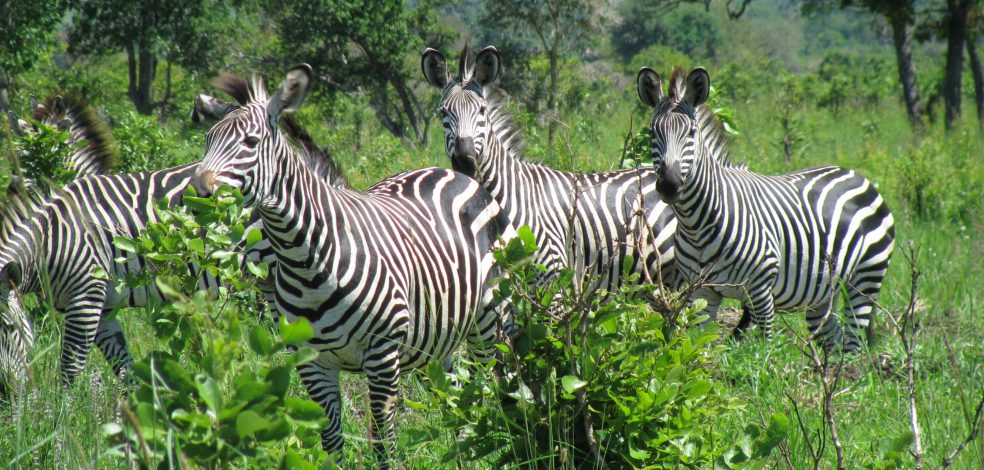As a behavioral ecologist, I’m spending a surprising amount of time reading and writing about plants these days. It turns out that plants are amazingly complex and interactive; you just need to know where and how to look. Today we will discuss the humble pea plant, how it is infected with a virus that is carried by an aphid that sucks its xylem, and how a herbivorous weevil fits into the whole system. The virus is the pea enation mosaic virus (PEMV), which causes pea leaves to yellow and wither, and also creates enations (scaly tissue) to develop on a leaf’s undersides. The aphid vector (a vector is the organism that carries a disease) is Acrythosiphon pisum, while the herbivorous weevil is Sitona lineatus.
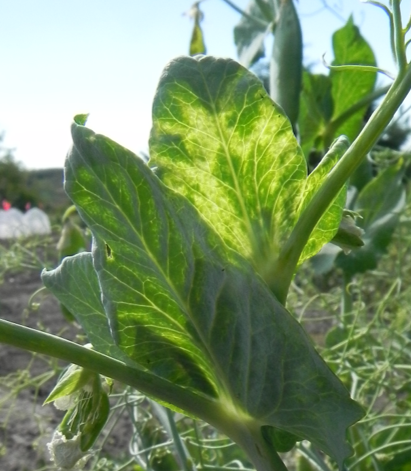
Pea plant infected with pea enation mosaic virus. Credit Paul Chisholm.
David Crowder has been studying plant/insect interactions for many years, and knew that most researchers who studied interactions between plants and insect vectors focused their attention on the plants, insects and the disease, but did not consider how other species in the community might affect this relationship. Paul Chisholm was a PhD student in Crowder’s lab; and working with two other researchers, they explored whether S. lineatus, an abundant herbivore of peas, influenced viral transmission. They expected that if the pea was first attacked by the weevil, it might be more susceptible to subsequent viral infection. Conversely, if the pea was infected by the virus, it might be less able to chemically defend itself against subsequent herbivory by the weevil.

(Left) Pea aphids. Credit: Shipher Wu under a Creative Commons Attribution 4.0 International Public License. (Right) Very adult pea leaf weevils, Sitona lineatus. Credit: Gail Hampshire under a Creative Commons Attribution 4.0 International Public License
It is easy to visually distinguish between PEMV-infected and uninfected plants, so the researchers could assess whether infected plants tended to suffer more defoliation by weevils than did uninfected plants. They visited 12 different fields in northern Washington and western Idaho, USA, and measured defoliation by counting the number of feeding notches left by the weevils after feeding on 3 – 10 infected pea plants and an equal number of nearby uninfected plants on each field (more feeding notches = more defoliation). They discovered that PEMV-infected plants tended to suffer substantially higher herbivory than did uninfected plants
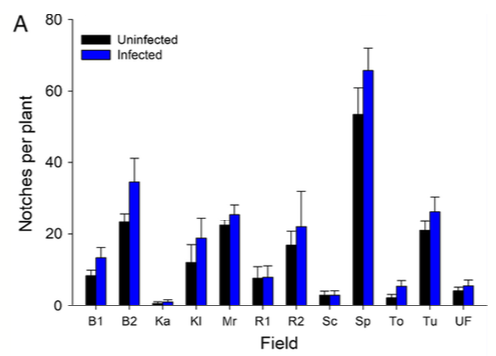
Herbivory (as measured by number of feeding notches) caused by weevils on paired uninfected (black bars) and PEMV-infected (blue bars) pea plants sampled from 12 different fields. Error bars for all figures represent 1 SE.
Given the correlation between herbivory and infection, Chisholm and his colleagues then explored whether (1) the weevil preferred to feed on infected plants, and/or whether (2) infective aphids preferred to feed on plants that had been damaged by herbivorous weevils. Both questions were answered with behavioral choice assays done in a greenhouse. First, the researchers created two groups of pea plants. The first group, sham infected, were fed on by aphids not carrying PEMV for 48 hours, while the second group of plants were fed on by PEMV-infected aphids for the same duration. Aphids were removed and PEMV infection developed within 15 days in the PEMV infected plants. The researchers then set up one sham infected and one PEMV-infected plant in a test cage, and released two weevils equidistant from the plants, allowing them to feed for six days. They discovered that aphids fed much more voraciously on the PEMV-infected plants.
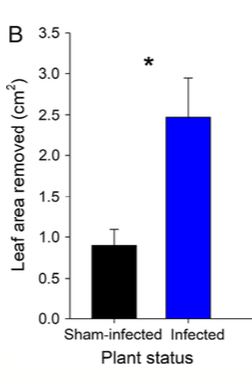
Mean leaf area removed from sham infected and PEMV-infected pea plants.
For the second experiment, the researchers again created two types of plants: undamaged – no herbivory, and damaged – 48 hours of weevil herbivory. Weevils were then removed, and one leaf from each plant was connected to each end of a tube, while still attached to each plant.

Experimental setup with tube attached to one leaf of each experimental plant. Aphids were introduced into the central tube. Credit Paul Chisholm.
The researchers added either 25 infectious or 25 non-infectious aphids, and allowed them 3 hours to choose a leaf. PEMV-infected aphids preferred damaged leaves, while uninfected aphids showed no preference.
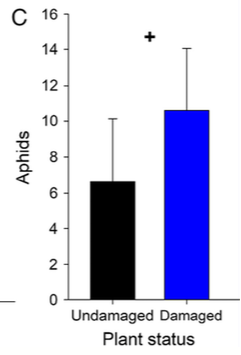
PEMV-infected aphid preference for undamaged (no herbivory) or damaged (weevil herbivory) leaves.
Chisholm and his colleagues then turned their attention to whether weevil herbivory made pea plants more susceptible to PEMV infection. In one experiment they allowed PEMV-infected aphids to feed on plants for 3 days, and then introduced 0, 1 or 3 weevils who fed on the plants for another 6 days. They used a protein assay to estimate the PEMV-titer (concentration) of each plant and discovered that the plants that were exposed to greatest herbivory had the highest PEMV titer (see graph below). In a second experiment the researchers allowed weevil herbivory before adding the aphids, and found no effect of prior herbivory on PEMV titer.
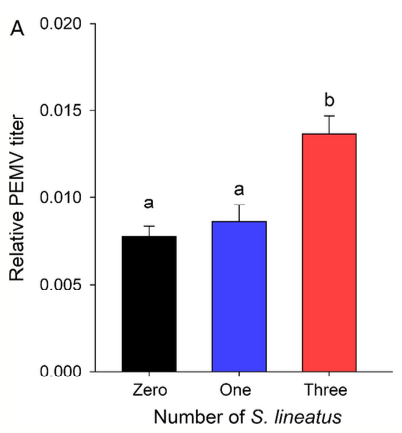
Relative PEMV-titer of infected leaves after they were subjected to herbivory by zero, one or three weevils for six days. different letters above bars indicate significant differences between treatments.
What causes these plant responses to challenges by PEMV and weevils? The researchers discovered that levels of three important plant hormones increased either in response to PEMV infection, weevil herbivory or both. At this point it is not clear how these different hormone levels interact to bring about the changes we’ve described.
The researchers conclude that weevil behavior has a profound influence on the interactions between aphids, the viruses they carry and the pea plants they feed on (and infect). The weevil is not a vector for the virus, yet it affects the virus directly by altering plant behavior and physiology and indirectly by altering the behavior of the vector (the aphids). PEMV outbreaks are more likely when weevils are abundant, as aphids prefer damaged plants, and feeding by weevils increased the PEMV titer in infected plants. Crowder argues that interactions in which a non-vector species influences the relationship between a host and its vector (and the pathogen it carries) are probably extraordinarily common in crop systems. So if we want to understand crop susceptibility to pathogens we need to cast a broad net and consider both the direct and indirect effects of a community of species that can influence how the crop responds to infection.
note: the paper that describes this research is from the journal Ecology. The reference is Chisholm, P. J., Sertsuvalkul, N. , Casteel, C. L. and Crowder, D. W. (2018), Reciprocal plant‐mediated interactions between a virus and a non‐vector herbivore. Ecology, 99: 2139-2144. doi:10.1002/ecy.2449. Thanks to the Ecological Society of America for allowing me to use figures from the paper. Copyright © 2018 by the Ecological Society of America. All rights reserved.
